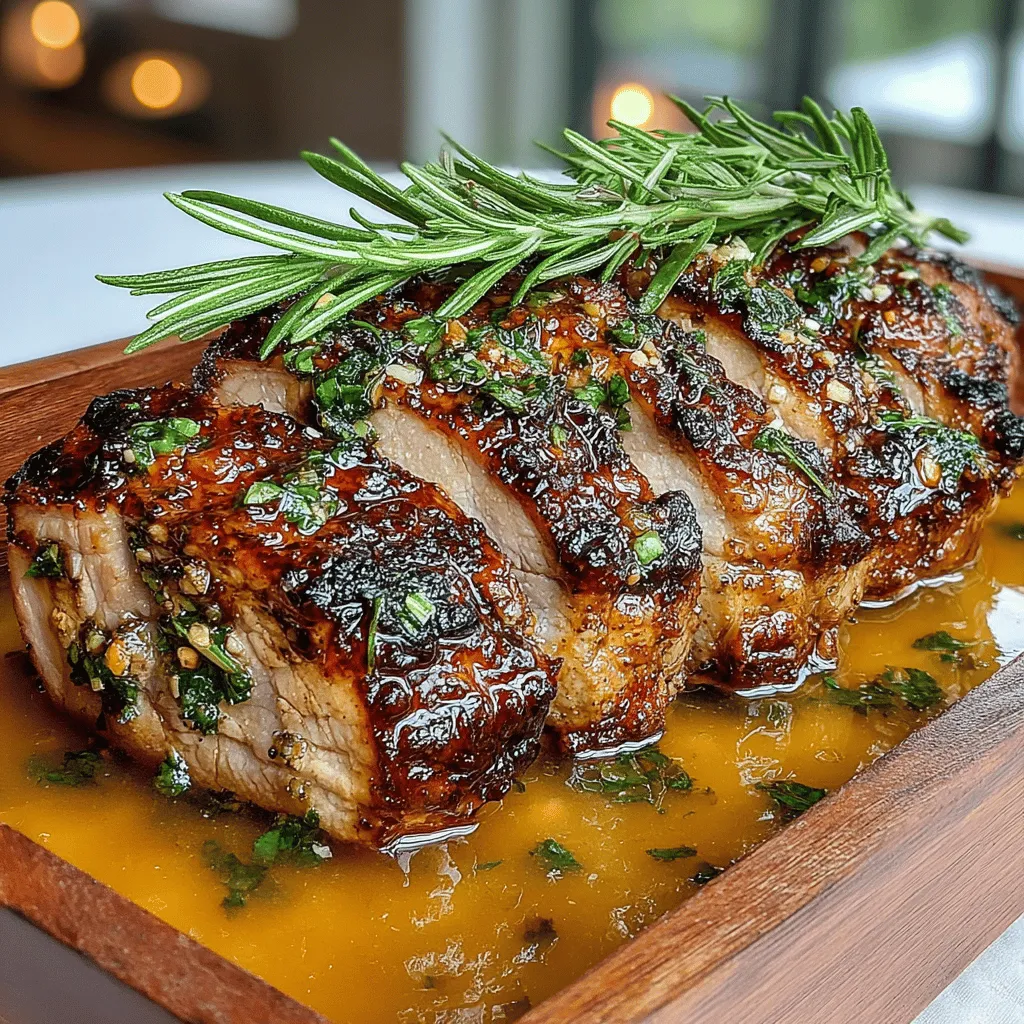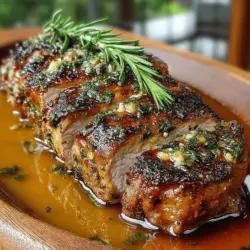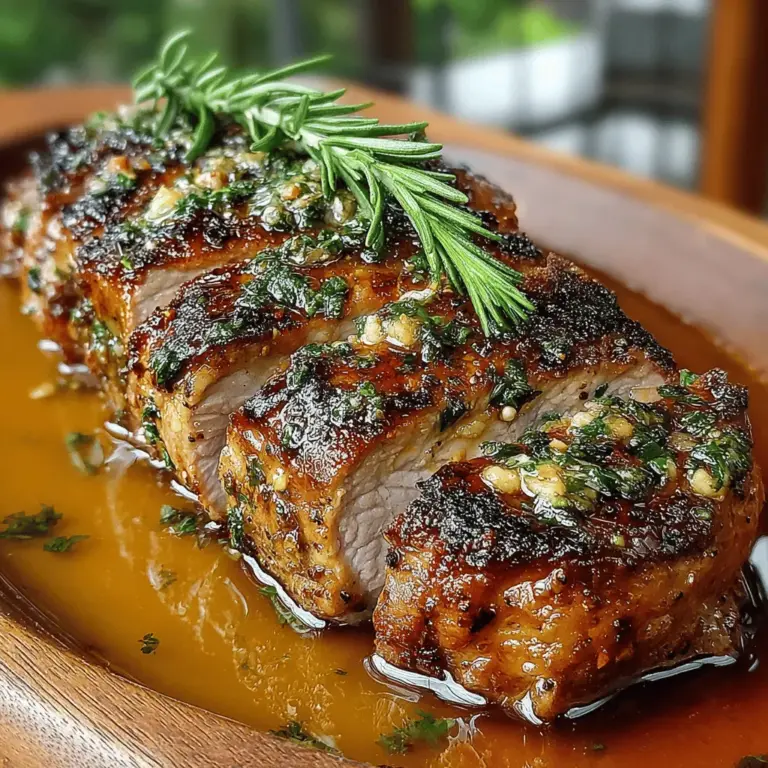Garlic Herb Roasted Pork Tenderloin: A Flavorful Delight for Every Occasion
When it comes to creating a memorable meal that balances flavor, tenderness, and ease of preparation, Garlic Herb Roasted Pork Tenderloin stands out as a quintessential choice for home cooks. This dish is not only a crowd-pleaser but also a versatile option that can elevate any dining experience, whether it’s a casual weeknight dinner or a special gathering with friends and family. The pork tenderloin, renowned for its juicy texture and mild flavor, becomes a canvas for the rich infusion of garlic and fresh herbs, resulting in a dish that is both satisfying and impressive.
What makes pork tenderloin particularly appealing is its remarkable tenderness. Unlike tougher cuts of pork, this cut is lean and cooks relatively quickly, making it an ideal option for those who want to serve a delicious meal without spending hours in the kitchen. The addition of garlic, rosemary, and thyme not only enhances the flavor profile but also brings a fragrant aroma that fills your home, making the cooking experience even more enjoyable. With just a few simple steps, you can create a dish that looks and tastes gourmet, providing a sense of accomplishment for any home chef.
Understanding Pork Tenderloin
Pork tenderloin is a prized cut of meat that comes from the loin of the pig. It is known for its leanness and tenderness, making it one of the most favored cuts in both professional and home kitchens. Unlike other cuts of pork, such as the shoulder or belly, which require longer cooking times to break down the connective tissues, pork tenderloin is incredibly tender and cooks quickly, typically taking only 20-30 minutes in the oven.
Nutritionally, pork tenderloin is an excellent source of protein. It is low in fat compared to other pork cuts, making it a healthier option for those looking to maintain a balanced diet. A single serving of pork tenderloin can provide a substantial amount of essential nutrients, including vitamins B6 and B12, niacin, and selenium, all of which play crucial roles in energy production and metabolic health.
In terms of cooking characteristics, pork tenderloin is versatile and forgiving. It can be prepared using various methods, including roasting, grilling, or pan-searing. However, it is essential to monitor the cooking time closely, as overcooking can lead to dryness. The ideal internal temperature for a perfectly cooked pork tenderloin is 145°F, followed by a resting period that allows the juices to redistribute, ensuring a moist and flavorful final dish.
Key Ingredients Overview
To create the perfect Garlic Herb Roasted Pork Tenderloin, you’ll need a selection of key ingredients that work harmoniously to enhance both flavor and texture.
– Fresh Herbs: The use of fresh rosemary and thyme is crucial in this recipe. Rosemary brings a robust, pine-like aroma that complements the savory nature of pork, while thyme adds a subtle earthiness. Together, they create a fragrant herbaceous backdrop that elevates the dish.
– Garlic: Garlic is a star ingredient in this recipe. Its pungent flavor mellows and sweetens as it roasts, infusing the pork with a rich, savory depth. The garlic not only enhances the taste but also contributes to the overall aroma, making your kitchen smell irresistible as the dish cooks.
– Lemon Juice and Zest: The addition of lemon juice and zest provides a bright contrast to the rich flavors of the pork and herbs. The acidity of the lemon helps to tenderize the meat while adding a refreshing zest that balances the dish, preventing it from feeling heavy.
– Olive Oil: Olive oil serves as the base for the marinade, helping to coat the pork tenderloin evenly and ensuring that the flavors penetrate the meat. It also aids in achieving a beautifully caramelized exterior during roasting.
– Dijon Mustard: This ingredient adds a tangy depth of flavor that complements the pork beautifully. The slight spiciness of Dijon mustard enhances the overall profile of the dish and helps to create a lovely crust when roasted.
– Salt and Pepper: Essential for seasoning, salt and pepper help to enhance the natural flavors of the pork and other ingredients. Proper seasoning is vital for achieving a well-balanced dish.
– Chicken Broth: Adding chicken broth to the roasting pan not only helps to keep the pork moist during cooking but also creates a flavorful base for any pan sauce you might want to serve alongside the dish.
Preparation Steps Explained
Now that you understand the significance of each ingredient, let’s delve into the preparation steps that will lead you to a successful Garlic Herb Roasted Pork Tenderloin.
Preheating the Oven
Before you begin the marination process, it’s important to preheat your oven to 400°F (200°C). This temperature is ideal for roasting pork tenderloin, ensuring that the meat cooks evenly and develops a beautiful golden-brown crust. Preheating the oven also helps to create a sealed environment that locks in moisture and flavor.
Making the Marinade
1. Combine the Ingredients: In a medium-sized bowl, mix together minced garlic, chopped fresh rosemary, thyme, lemon juice, lemon zest, Dijon mustard, olive oil, salt, and pepper. This combination of ingredients will create a fragrant marinade that will infuse the pork with flavor.
2. Prepare the Pork Tenderloin: Trim any excess fat or silver skin from the pork tenderloin, as this can prevent the marinade from penetrating the meat. Pat the tenderloin dry with paper towels to help the marinade adhere better.
3. Marinate the Pork: Place the pork tenderloin into a resealable plastic bag or a shallow dish. Pour the marinade over the meat, ensuring that it is thoroughly coated. Seal the bag or cover the dish and let the pork marinate for at least 30 minutes at room temperature, or up to 4 hours in the refrigerator for a more intense flavor.
4. Bring to Room Temperature: If you marinated the pork in the refrigerator, remove it about 30 minutes before cooking to allow it to come to room temperature. This step is crucial for even cooking.
As you prepare the Garlic Herb Roasted Pork Tenderloin, the aroma of garlic and herbs will begin to fill your kitchen, setting the stage for a delightful culinary experience. The combination of fresh ingredients and straightforward steps makes this dish an accessible yet impressive option for any home cook eager to create a flavorful meal. Stay tuned as we delve into the roasting process and reveal the secret to achieving a perfectly cooked pork tenderloin that will surely impress your guests.

Marinating Techniques: Tips for Maximizing Flavor Infusion
The secret to a delicious Garlic Herb Roasted Pork Tenderloin lies in the marinade. Marinating the pork not only enhances its flavor but also helps tenderize the meat. Here are some effective techniques to maximize flavor infusion:
1. Choose the Right Marinade: A balanced marinade includes an acid (like vinegar or citrus), oil, and flavorful herbs or spices. For this recipe, a mix of olive oil, minced garlic, fresh rosemary, thyme, salt, and pepper works wonders.
2. Time: While marinating for just 30 minutes will impart some flavor, marinating for 4-24 hours is ideal. If you have time, opt for an overnight marinade in the refrigerator. This duration allows the flavors to penetrate deeper into the meat.
3. Use a Resealable Bag: Place the pork tenderloin in a resealable plastic bag with the marinade. This method ensures that the marinade evenly coats the pork and allows for better flavor absorption.
4. Massage the Marinade: After sealing the bag, gently massage the marinade into the meat. This not only helps distribute the flavors but also breaks down the muscle fibers, making the pork more tender.
5. Keep It Cool: Always marinate in the refrigerator to prevent bacterial growth. If you marinate for an extended time, check the meat periodically to ensure it’s not becoming too salty or mushy.
Searing the Pork: The Science Behind Creating a Crust
Searing is a crucial step in the cooking process that not only enhances the flavor but also improves the presentation of your dish. Here’s why searing matters:
1. Maillard Reaction: When you sear meat over high heat, a chemical reaction known as the Maillard reaction occurs. This reaction creates a rich brown crust on the surface, adding depth of flavor that enhances the overall taste of the dish.
2. Temperature Matters: Preheat your skillet or oven to a high temperature before adding the pork. You want the surface to sizzle upon contact to achieve that perfect crust.
3. Avoid Overcrowding: If you’re cooking multiple tenderloins, ensure there’s enough space in the pan. Overcrowding can cause the temperature to drop, resulting in steaming rather than searing.
4. Don’t Rush It: Allow the pork to cook undisturbed for a few minutes on each side. This helps develop a nice crust. Use a meat thermometer to check for doneness rather than cutting into the meat prematurely.
Deglazing the Pan: How It Enhances Flavor in the Final Dish
After searing the pork, the fond (the brown bits left in the pan) is a treasure trove of flavor. Deglazing is the process of adding liquid to this fond, lifting those delicious bits off the bottom of the pan. Here’s how to do it:
1. Choose Your Liquid: Common deglazing liquids include broth, wine, or even water. For this recipe, a splash of white wine or chicken broth amplifies the flavors beautifully.
2. Heat the Pan: After removing the seared pork, keep the skillet hot and add the liquid. As it sizzles, use a wooden spoon to scrape the bottom of the pan, lifting the fond and mixing it into the liquid.
3. Reduce the Sauce: Allow the deglazing liquid to simmer for a few minutes until it reduces slightly, concentrating the flavors. This sauce can be drizzled over the roasted pork tenderloin for an extra layer of taste.
Cooking the Pork Tenderloin
Roasting Process: Temperature Control and Timing
Roasting is a straightforward yet effective method for cooking pork tenderloin. Here’s how to do it right:
1. Preheat the Oven: Set your oven to 400°F (200°C). This temperature is ideal for roasting pork tenderloin, ensuring that it cooks through without drying out.
2. Prepare the Pork: After marinating, remove the pork tenderloin from the marinade and pat it dry with paper towels. This step is essential for achieving a good sear.
3. Sear the Pork: Heat a skillet over medium-high heat and add a tablespoon of olive oil. Once hot, add the pork tenderloin and sear on all sides until golden brown, about 3-4 minutes per side.
4. Transfer to the Oven: After searing, transfer the skillet (if oven-safe) or the pork to a baking dish. Roast it in the preheated oven for 20-25 minutes, or until the internal temperature reaches 145°F (63°C).
Understanding Internal Temperature: Why 145°F Is Crucial
Cooking pork to the right internal temperature is essential for both safety and quality:
1. Food Safety: The USDA recommends cooking pork to an internal temperature of 145°F, followed by a three-minute rest. This temperature ensures harmful bacteria are eliminated.
2. Juiciness and Flavor: Cooking to 145°F also allows the pork to retain its moisture, making it tender and flavorful. Overcooking will lead to dry, tough meat, so using a meat thermometer is highly recommended.
How Resting the Meat Affects Juiciness and Texture
Resting the pork tenderloin after cooking is a crucial step often overlooked. Here’s why it matters:
1. Redistribution of Juices: When meat cooks, the juices move towards the center. Resting allows these juices to redistribute throughout the meat, ensuring each slice is juicy.
2. Optimal Texture: Resting for 5-10 minutes before slicing helps the meat retain its shape and prevents it from drying out.
Visual Cues for Doneness: What to Look For
Besides using a thermometer, there are visual cues to determine if the pork is done:
1. Color: The meat should be a pale pink with clear juices (not red). A slightly rosy center is perfectly safe when cooked to the right temperature.
2. Firmness: Press the pork gently with a finger. It should feel firm but spring back slightly. If it feels soft or mushy, it may need more cooking time.
Serving Suggestions
Presenting your Garlic Herb Roasted Pork Tenderloin beautifully can elevate your dining experience. Here are some serving suggestions:
Suggested Side Dishes: Pairing with Roasted Vegetables or Starches
To create a balanced meal, consider pairing the pork with complementary side dishes:
– Roasted Vegetables: A medley of seasonal vegetables like carrots, Brussels sprouts, and sweet potatoes drizzled with olive oil and herbs make an excellent pairing.
– Starches: Creamy mashed potatoes, garlic-infused rice, or a wild rice pilaf can help soak up any sauce and add a satisfying element to the plate.
Garnishing Tips: Using Fresh Herbs for Color and Flavor
Garnishing not only adds visual appeal but also enhances flavor:
– Herb Sprigs: Use fresh sprigs of rosemary or thyme to garnish your plated pork. It adds a pop of color and hints at the dish’s flavors.
– Citrus Zest: A sprinkle of lemon or orange zest can brighten the dish and add a fresh, zesty note.
Creating a Complete Meal: Balancing Flavors and Textures on the Plate
When plating, aim for a balance of flavors and textures:
1. Colorful Presentation: Use a vibrant mix of roasted vegetables and herbs to create an inviting presentation.
2. Layering Flavors: Drizzle the deglazed sauce over the pork for added flavor and moisture. Serve with a side of creamy or tangy sauce to contrast the savory notes of the pork.
3. Texture Contrast: Aim for a combination of textures on the plate. The tender pork should be complemented by crispy vegetables and creamy starches for a satisfying experience.
Flavor Variations and Customizations
One of the great aspects of Garlic Herb Roasted Pork Tenderloin is its versatility. Here are some ways to customize the recipe:
Alternative Herbs and Spices That Can Be Used
Feel free to experiment with different herbs and spices to suit your taste:
– Herbs: Swap rosemary and thyme for sage or oregano for a different flavor profile.
– Spices: Adding a pinch of paprika or chili powder can give the dish an extra kick.
Suggestions for Marinating Overnight or Using Different Marinades
For a twist, try different marinades:
– Asian-Inspired Marinade: Use soy sauce, ginger, and sesame oil for an Asian flair.
– Citrus Marinade: A marinade made of orange juice, lime, and cilantro can add brightness to the dish.
Cooking Methods: Grilling vs. Roasting
While this recipe focuses on roasting, grilling can also yield delicious results:
– Grilling: Preheat your grill to medium-high and cook the marinated pork tenderloin for about 20 minutes, turning occasionally. Use a meat thermometer to ensure it reaches 145°F.
– Sous Vide: For perfectly cooked pork, consider sous vide cooking. Cook the marinated tenderloin in a water bath at 145°F for 1-2 hours, then sear it for a crust.
Conclusion
Garlic Herb Roasted Pork Tenderloin is a delightful dish that brings together simple ingredients and techniques to create a meal that is both impressive and satisfying. From the marinating process to the final presentation, each step enhances the flavor and quality of this versatile pork tenderloin.
Whether you’re preparing a weeknight dinner or hosting a special occasion, this recipe is sure to impress your family and friends. By mastering the techniques of marinating, searing, and roasting, you can elevate your culinary skills and serve a dish that looks as good as it tastes.
As you explore the flavors of Garlic Herb Roasted Pork Tenderloin, consider experimenting with different herbs, marinades, and cooking methods to make this dish your own. The satisfaction of crafting a delicious meal is truly rewarding, and with this recipe in your repertoire, you’ll be well on your way to becoming a culinary star in your kitchen. Enjoy your cooking adventure!

